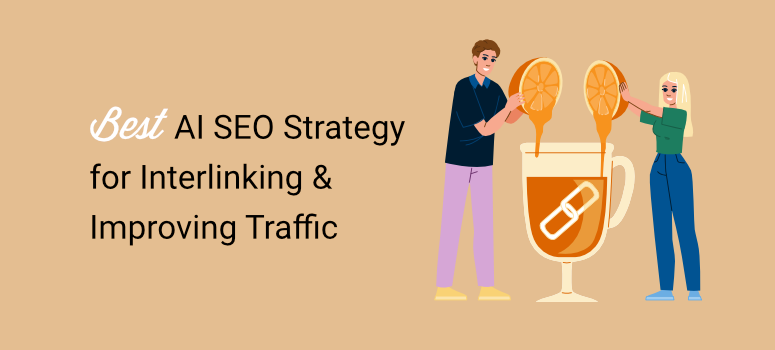
As an SEO expert with 10 years of experience, I used to thrive on manual internal linking. While others relied on automation, I found opportunities they missed through deep content analysis before adding a single link.
As my business scaled, I invested in expensive SEO tools like SEMRush and Ahrefs.
But this still frustrated me because it required endless manual work to find the right internal link. I’d spend hours analyzing data, then more hours adding the actual links in the WordPress sites.
Everything changed when I discovered WordPress SEO tools that actually bridge interlinking automation with strategic control. As both an SEO and WordPress expert, this connection has been a game-changer.
Remember, AI is transforming search behavior, and sites need genuine topic authority to dominate.
And Interlinking is one of the best ways to achieve this.
As a result, the manual internal linking approach can’t scale, while pure automation lacks an SEO strategy.
The solution? WordPress plugins that understand both SEO strategy and WordPress implementation.
I’ll show you my proven system for building topic authority using three powerful tools: AIOSEO for smart internal linking, LowFruits for strategic keywords, and SEOBoost for AI content optimization.
What you’ll learn:
- Master AIOSEO’s Link Assistant for automated internal linking
- Use LowFruits to identify topic authority opportunities
- Leverage SEOBoost’s AI for maximum content impact
- Build the expertise that makes you a recognized niche expert
With that out of the way, let us first look at what you need before setting up WordPress interlinking automation.
What You’ll Need Before We Start
Before diving into this authority-building strategy, let’s make sure you have everything ready. This setup takes about 2-3 hours but creates a system that works for months.
Required Tools:
Check out the table below to see how I use each of these SEO tools in my internal link strategy.
| Tool Name | Primary Purpose | Specific Features Used | Authority Building Role | Expected Results |
|---|---|---|---|---|
| AIOSEO (Link Assistant) | An automated internal linking system that finds strategic connections | Linking Opportunities Dashboard, Bulk Link Addition, Cornerstone Content Marking | Creates hub-and-spoke architecture connecting pillar pages to cluster content | New strategic links, improved engagement, eliminated orphaned posts |
| LowFruits | Strategic keyword research for low-competition opportunities | Keywords Finder, SERP Weakness Analysis, Keyword Clustering | Identifies topic clusters and content hierarchy for comprehensive expertise | 3-5 main topic clusters, better keyword opportunities, clear content architecture |
| SEOBoost | AI content optimization for maximum linking potential | Content Analysis, Gap Analysis, Real-time Scoring | Creates link-worthy content by optimizing pages to authority standards | High quality scores, comprehensive pillar content, improved topic depth |
Skill Level: Beginner with basic SEO knowledge. You should understand concepts like internal links, keywords, and content optimization, but I’ll explain the advanced techniques step-by-step.
If you need a refresher course, start by going through my complete SEO WordPress guide.
Time Investment:
- Initial setup: 2-3 hours
- Weekly maintenance: 30 minutes
- Monthly optimization: 1 hour
What We’ll Accomplish: By the end of this tutorial, you’ll have an automated system that identifies and implements strategic internal links across your content.
This will help position you as the comprehensive expert in your niche.
Why AI-Powered Interlinking Builds Topic Authority
In the past, search engines like Google ranked pages with exact keywords and many backlinks. Not anymore!
Today, Google doesn’t just rank individual pages anymore. Instead, it ranks websites based on comprehensive topic expertise.
Think about it this way.
When someone searches “content marketing,” Google wants to send them to a site that covers everything about the topic, content marketing, not just one article that happens to mention it.
The new search reality is that over 58% of searches now end without clicks, thanks to AI-powered results.
While this approach has turned traditional SEO strategies on its head, it also means Google is getting better at understanding complete topics, not just matching keywords.
As a result, sites that demonstrate deep knowledge across entire subject areas get rewarded. But sites with scattered, unconnected content get left behind.
Why Internal Linking Signals Expertise:
Internal links tell Google how your content connects.
When you link from your “Content Marketing Strategy Tools” article to a more in-depth article in the same space, like the “Best Email Newsletter Plugins,” you’re showing Google these topics relate and that you understand them.
When you strategically do this across dozens or hundreds of articles, Google starts seeing you as the comprehensive source.
That’s topical authority!
The Manual Problem:
Most people try building internal links manually. They remember to add a few links here and there. But creating the comprehensive web of connections needed for true authority? Nearly impossible by hand.
The AI Solution:
Smart automation finds every opportunity. Tools like AIOSEO Link Assistant analyze your entire content library, identifying connections you’d never spot manually.
Plus, when you combine strategic keyword research from LowFruits with AI content optimization from SEOBoost, you create content specifically designed for authority building.
The result? You become the go-to expert Google recommends when people search your topic area.
How to build an Effective AI Interlinking SEO Strategy
Now that you understand the shift in SEO, let us see how you can take full advantage of AI in improving your internal linking process.
Now, I have broken this strategy into sections to make it easy for you to follow. To read a specific step, click on one of the links below.
With that said, let us get into it.
Part 1: Set up AIOSEO Link Assistant
Timeframe: 20 minutes
AIOSEO Link Assistant is a premium All in One SEO feature that automatically scans your content and suggests strategic internal links to build topic authority.
Think of it as your personal linking strategist, analyzing every piece of content and finding opportunities you’d never spot manually.
Installing and Activating Link Assistant
While AIOSEO offers a free SEO plugin, you can only get the Link Assistant feature in the pro plan or higher.
You can check out this post on AIOSEO Pro vs Free to see the difference between the two versions.
First, make sure you have AIOSEO Pro or Elite installed on your WordPress site. All you have to do is go to the official All in One SEO website and purchase a plan.
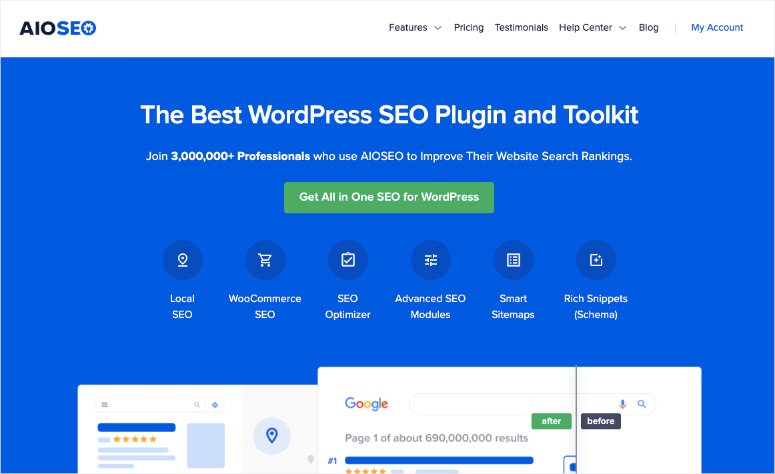

After this, go to your AIOSEO dashboard and navigate to Downloads. Here, download the ZIP file to your PC. And while here, also copy the License key, you will need it later to activate the pro version.
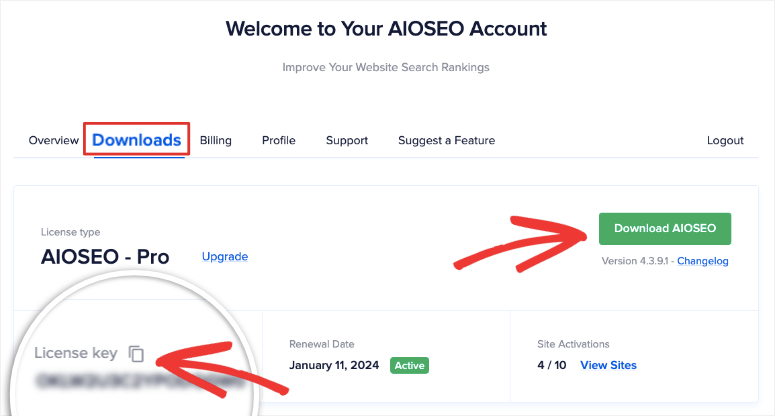

After this, head to your WordPress dashboard and install the AIOSEO plugin as you would any other plugin.
If you face any issues, check out my detailed guide on how to install plugins here.
After installation, go to AIOSEO » General Settings and enter your license key to unlock all premium features.
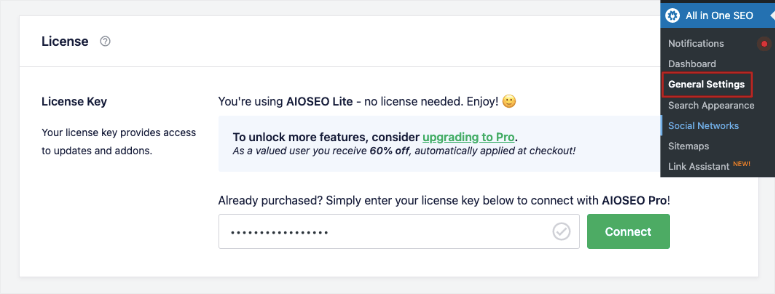

Next, head to AIOSEO » Feature Manager to see a list of available addons. Then, find “Link Assistant” and toggle it to Active.
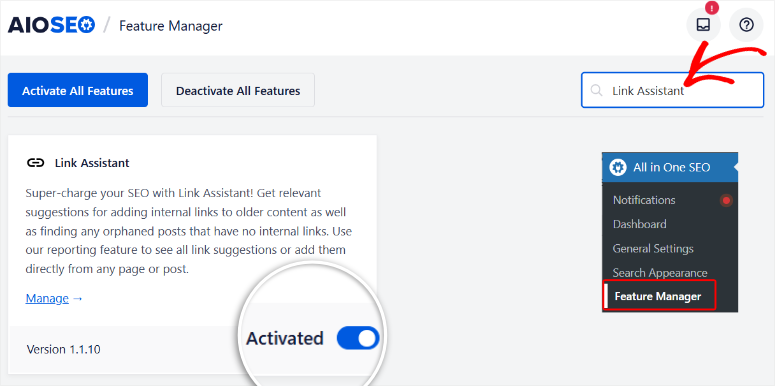

The moment you activate it, AIOSEO starts crawling your site in the background.
After this, AIOSEO will visualize the Important Issues, Recommended Improvements, Good Results, and more in graphs and charts.
This initial crawl can take 10-30 minutes, depending on your content volume.


Understanding Your Link Assistant Dashboard
After the SEO scan, navigate to AIOSEO » Link Assistant » Overview to access your command center for topic authority building.
Here’s what each metric means:
- Posts Crawled: Total content pieces analyzed for linking opportunities
- Orphaned Posts: Content with zero inbound internal links. These are authority killers
- Internal Links: Total internal connections across your site
- External Links: Links pointing to other websites
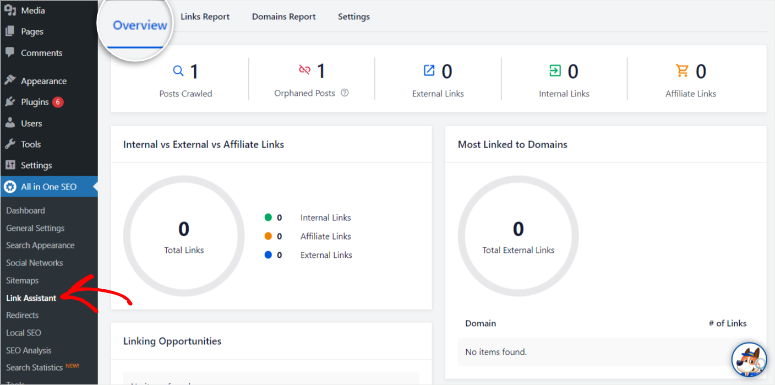

Here, you’ll likely see some eye-opening numbers.
For example, most sites have 20-40% orphaned content, pages with no inbound internal links. These represent immediate opportunities to boost topic authority.
My strategy is to make sure that each page and post has at least 3-5 internal links for every external link. This keeps link equity flowing within your site instead of bleeding out to competitors.
Let me show you how to make this linking strategy a reality.
Configuring Strategic Settings
Next, select AIOSEO » Link Assistant » Settings to configure your automation preferences.
Then, under Post Types, select which content types to analyze. For example, I check Published, Scheduled, Draft, Pending, and Private. If you have custom post types for products or portfolios, include those too.
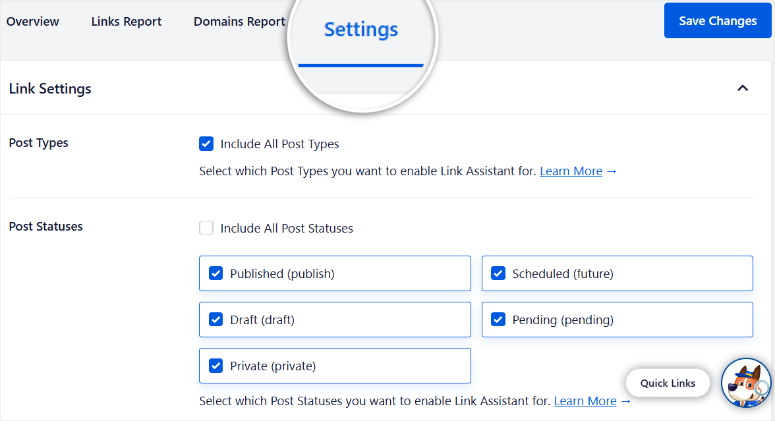

Then scroll down on this page and pay attention to these key options:
- Words to Ignore: Add broad terms you don’t want auto-linked. For example, if you write about “marketing” constantly, you might ignore it to prevent over-linking.
- Sentences to Skip at Beginning: Set this to 2-3. This prevents links from cluttering your introductions.
- Here’s my personal trick: Use the “Exclude Pages/Posts” feature to remove low-quality or outdated content from linking suggestions.
- This ensures link equity flows only to your best, most relevant pages that support your topic authority strategy.
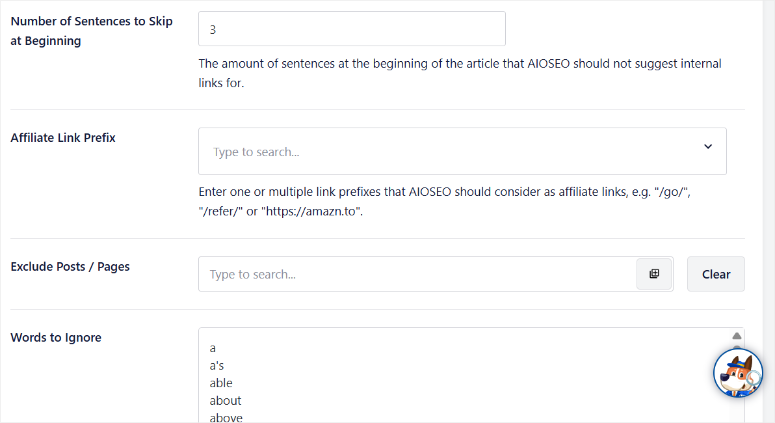

Quick Verification Test
After setting up the Link Assistant feature, make sure everything’s working properly. To do this, go to AIOSEO » Link Assistant » Links Report and select the “Linking Opportunities” filter.
Here, you will see your posts with linking opportunities displayed with the publishing date, internal, and external links. Plus, if you are running an affiliate site, you will also see the affiliate links.
Here, you can quickly identify pages and posts that have just a few internal links before you start the process.
On top of that, you can open the individual pages and manually add the internal links you want.
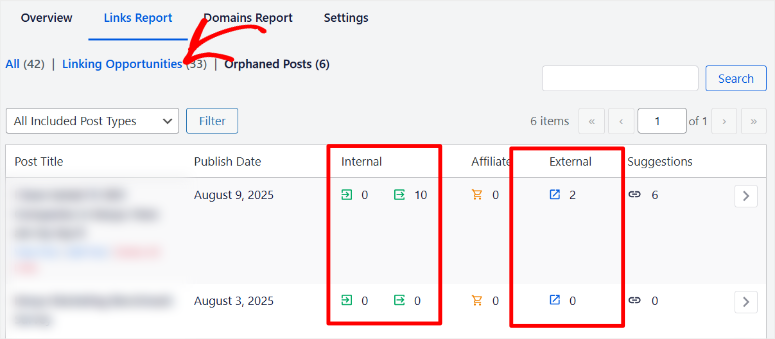

Apart from seeing all the pages with linking opportunities, you can also see ones without links at all! We call these orphaned posts.
So to see these posts, go to the Orphaned Posts tab. You will see the same metrics you did in the Link Opportunity tab.
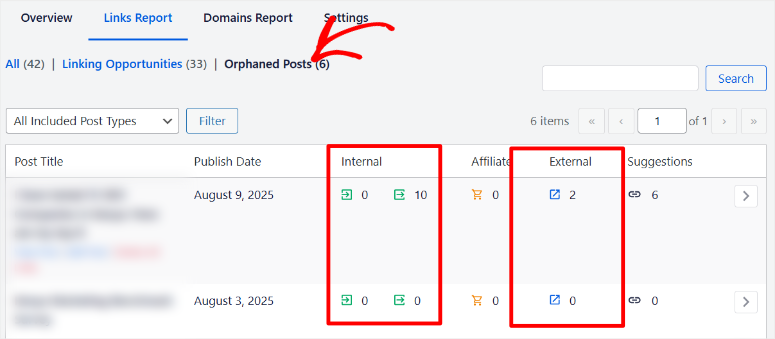

But now comes the fun part. On both the Linking Opportunity or Orphaned Posts tabs, there is a small arrow at the end of each post. Select it to open the interlinking opportunities for each post.
You get both InBound Internal and Outbound internal link suggestions. As a result, you can add both links coming to the post or leaving the post.
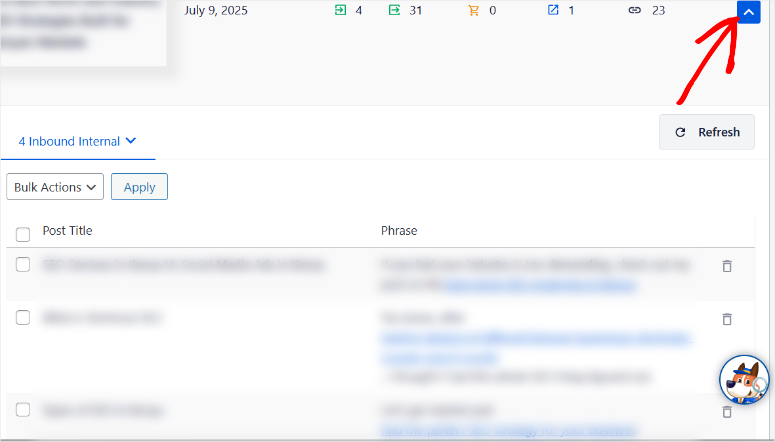

That’s it! You can use these suggestions to automate your interlinking.
Check out the latest AIOSEO review to see everything you can do with this SEO plugin.
With that done, the foundation is set. Next, we’ll use LowFruits to identify the strategic keywords that will guide your linking decisions.
Part 2: Strategic Keyword Research with LowFruits
TimeFrame: 25 minutes
Before AI Overviews and AI SEO became a thing, we optimized individual pages for individual keywords.
But now, topic authority is the best SEO approach. Today, we create content clusters. That is, we group related topics and keywords. Then create content around this to demonstrate expertise.
LowFruits excels at finding these cluster opportunities, especially the “low-hanging fruit” keywords where you can actually compete.
Let me show you how to use LowFruits to identify clusters and then interlink these content groups.
Setting Up Your LowFruits Analysis
First, you need a LowFruits account. So, go to their official site and sign up for a plan. The best part is you can start with a free trial to see if lowFruits is actually right for you.
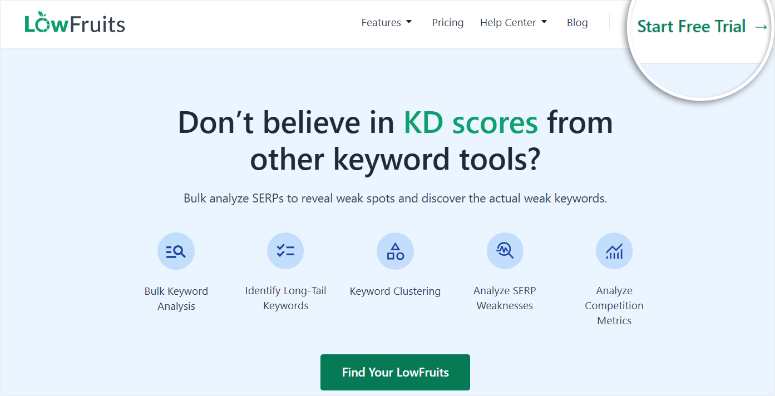

After this, log in to your LowFruits account and head to the Keywords Finder tool. This is where we identify the foundation of your topic authority strategy.
Start with your main topic area. If you’re in digital marketing, don’t just search “digital marketing.” Instead, try broader seed terms like:
- “content marketing tips”
- “email marketing strategy”
- “social media marketing”
Here, enter your first seed keyword and hit Generate.


The reason I use this SEO tool is that LowFruits actually examines the actual search results, not just keyword difficulty scores that other tools rely on.
Understanding the Opportunity Signals
Pay attention to LowFruits’ unique visual indicators:
Green Fruit Icons: These show keywords where low-authority sites rank in the top 10. Perfect targets for your internal linking strategy.
SERP Weakness Scores: Look for Domain Authority (DA) scores of less than 20. These indicate opportunities where strategic content and internal linking can help you outrank current results.


Keyword Clusters: LowFruits automatically groups related keywords. These clusters become your topic authority blueprint.
Here’s what I love about this approach: instead of chasing competitive keywords, you’re finding gaps where comprehensive topic coverage can win.
Building Your Topic Cluster Map
Next, select the Clusters tab to see how your keywords naturally group together. This reveals your content architecture for maximum topic authority.
For example, a “content marketing” cluster might include:
- Content marketing strategy (pillar page)
- Marketing tips (cluster page)
- Blog content ideas (cluster page)
- Content calendar templates (cluster page)
- Content marketing metrics (cluster page)
Each cluster needs one comprehensive pillar page that covers the broad topic, supported by several detailed cluster pages.
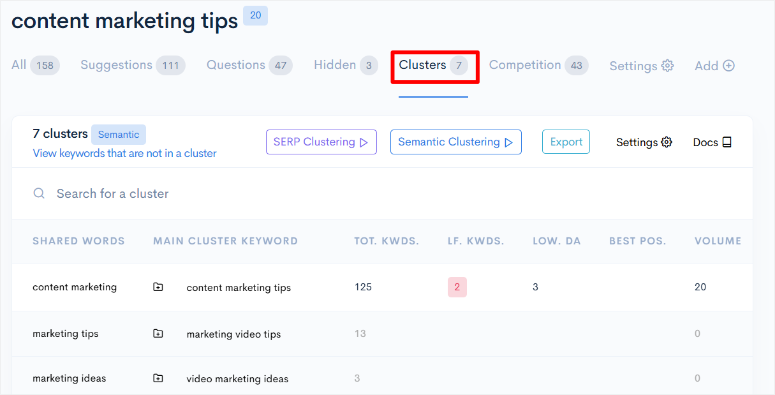

Exporting Your Strategic Keywords
Once you’ve identified 3-5 main topic clusters, export them using the Export button.
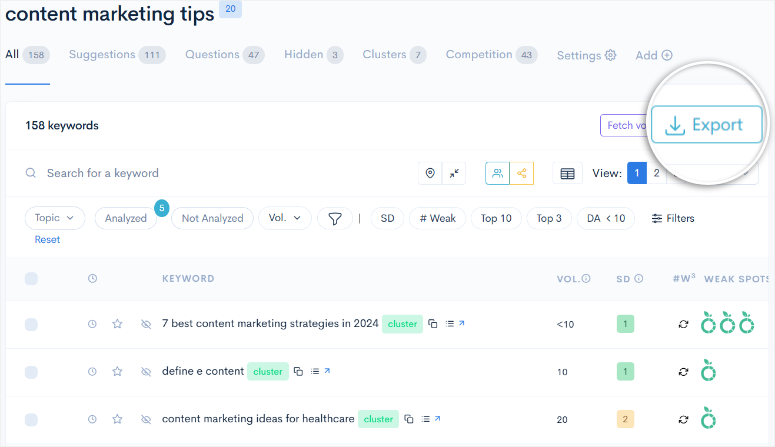

Remember to save this as a spreadsheet since you’ll reference it constantly. Create three columns in your spreadsheet:
- Pillar Pages: Broad topics for comprehensive coverage
- Cluster Pages: Specific subtopics that support pillars
- Long-tail Content: Detailed articles that link back to clusters
This hierarchy becomes your internal linking roadmap. Every piece of content should connect logically to others in its cluster.
The Authority-Building Opportunity
As you can see, LowFruits doesn’t just find easier keywords; it reveals topic gaps where you can build in-depth guides instead of random content pieces.
Don’t try to create content for every keyword immediately. Start with one cluster with around 5-8 related keywords. Then, build that topic authority first, before expanding to new clusters.
This focused approach creates the comprehensive expertise that Google rewards with higher rankings across your entire topic area.
For a full look at what this SEO tool does, check out my complete LowFruits review.
With your keyword clusters mapped, it’s time to optimize your content for maximum linking potential using SEOBoost.
Part 3: Content Optimization with SEOBoost
TimeFrame: 20 minutes
The truth is, internal linking only works when you’re linking to genuinely valuable content. Random internal links only confuse Google and dilute your topic authority signals.
That’s why I use SEOBoost to ensure every piece becomes worth linking to before implementing any internal linking strategy.
Analyzing Your Topic Competition
First, you need an SEOBoost account. To get one, head to the official SEO tool website and purchase a plan.
Like with LowFruits, I recommend you start with the SEOBoost 14-day free trial to see if it is the right fit for you.
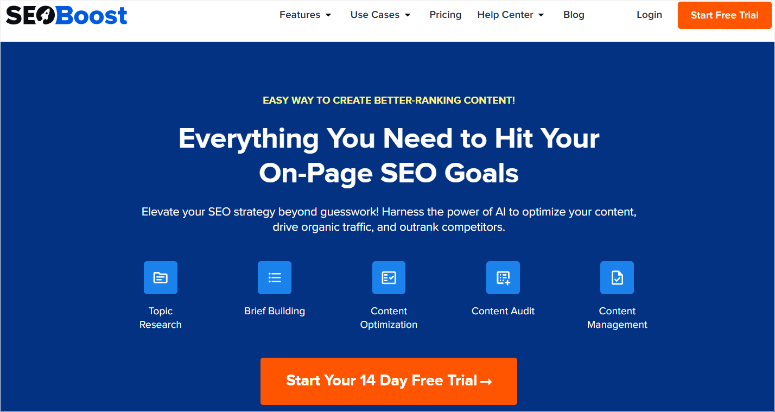

After this, log in to SEOBoost and navigate to the Content Analysis tool. Then, enter your primary keyword from your LowFruits cluster research.
Next, SEOBoost will analyze the top 30 search results, showing you exactly what type of content Google rewards in your niche.
Pay attention to these key metrics:
- Average word count of ranking pages
- Content depth and topic coverage
- Semantic keywords competitors use
- Content structure patterns
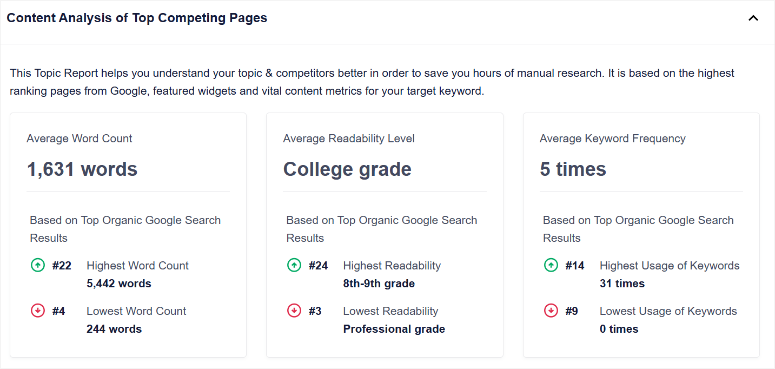

This isn’t about copying competitors. It’s about understanding the baseline content quality needed to justify internal links.
The Strategic Content Gap Analysis
You can also use the SEOBoost Content Analysis Report to find content gaps that competitors miss entirely and reveal your biggest opportunity.
On the Content Analysis Report page, navigate to the “Overview of Top Competitor Pages” tab.
Here, you’ll see each ranking page with essential metrics including SEO scores, word counts, readability levels, and content structure.
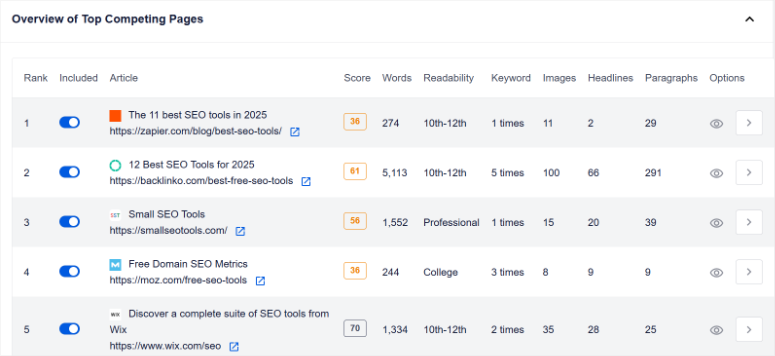

Select the expand arrow next to any competitor’s URL to reveal their heading structure and topic coverage. This shows you exactly what they’re covering, and what they’re not.
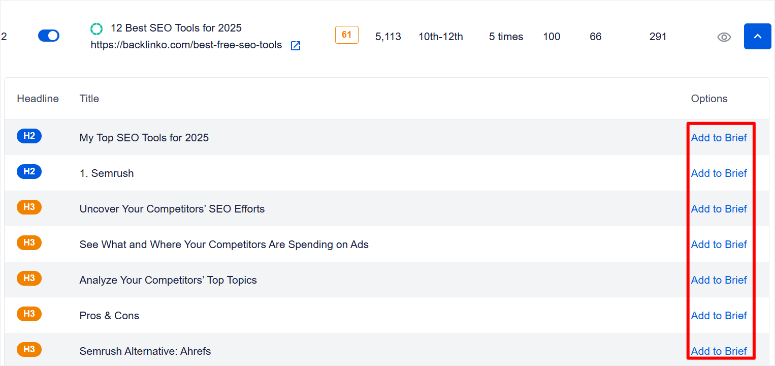

To fully take advantage of my interlinking strategy, look for patterns across multiple competitors, and don’t just randomly add headers to your brief.
If the top three ranking pages all skip a subtopic that your LowFruits research shows people search for, you’ve found gold.
This helps you create comprehensive content that fills these gaps, and you’ll have natural internal linking opportunities competitors can’t match. You’re literally covering territory they’ve left unexplored.
This content gap approach creates the comprehensive expertise that Google rewards with higher topic authority across your entire content cluster.
Creating Authority-Worthy Pillar Pages
Next, use SEOBoost’s Content Brief feature we used to add topics to the guide for your pillar page keywords. This generates comprehensive outlines showing exactly what to cover for maximum authority.
For example, a “content marketing strategy” pillar page might need:
- 15+ subtopics for comprehensive coverage
- 2,500-3,500 words minimum
- 25+ semantic keywords naturally integrated
- Clear section structure for easy linking
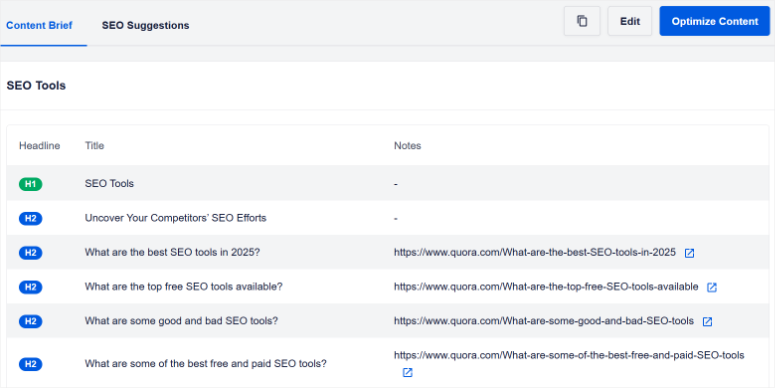

My approach is to create pillar pages that become the best resource for the topic. When other content links to them, it feels natural because they truly deserve the reference.
Optimizing Existing Content for Link-Worthiness
Once done, run your existing content through SEOBoost’s Content Audit feature. This reveals which pages need optimization before they become effective internal linking targets.
Look for content scoring below 70/100 in SEOBoost. These pages need work before you start sending internal links their way.


Common issues I see:
- Thin content that doesn’t justify links from comprehensive articles
- Missing semantic keywords that would make linking feel natural
- Poor structure that makes it hard to reference specific sections
Quality Control for Link Targets
Before implementing your AIOSEO internal linking strategy, run a final check on your key pages using SEOBoost’s real-time scoring.
Each page should score 80+ before becoming a major internal linking target. This ensures your automated linking actually builds authority instead of just creating busy work.
The result? When AIOSEO suggests linking to your optimized content, those links carry genuine value for both users and search engines.
WordPress Integration Advantage
Now, SEOBoost is fast becoming my favorite content optimization tool because it works directly inside WordPress through AIOSEO integration.
In a nutshell, SEOBoost functions as AIOSEO’s built-in writing assistant. So, once you have both tools connected, you can optimize content without ever leaving your WordPress dashboard.
All you have to do is go to your WordPress page or post editor and look for the “Generate a New Report” option at the bottom within the AIOSEO settings section.
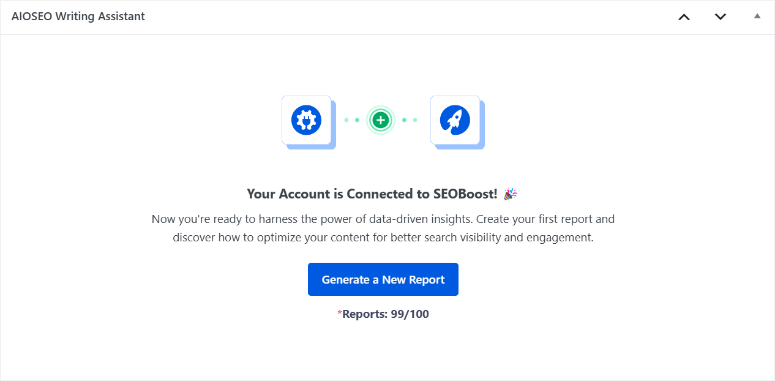

Enter your target keyword, search region, and language. After this, SEOBoost generates a comprehensive optimization report right in your WordPress editor without switching platforms.
The report includes three key sections:
- Overview: Your content’s SEO grade compared to top 30 competitors
- Optimization Wizard: Related terms and their usage recommendations
- Competitor List: Benchmarks from currently ranking pages


The best part? Everything syncs between your SEOBoost dashboard and WordPress. As a result, reports you create in WordPress appear under Topical Reports in your SEOBoost account.
This seamless integration means you can optimize content without the constant platform switching that kills productivity.
In the end, you can research in SEOBoost, optimize in WordPress, then implement internal links through AIOSEO – all in one connected workflow.
Now, with your content optimized for maximum impact, you’re ready to implement the strategic internal linking system that transforms scattered pages into comprehensive topic authority.
Check out my full SEOBoost review for all the details on how to fully utilize its powerful features.
Implementing Your Authority-Building Link Strategy
45 minutes | Connect all three tools into one powerful system
This is where everything clicks together.
- Your keyword clusters from LowFruits guide the strategy.
- Your optimized content from SEOBoost provides worthy link targets.
- Now, AIOSEO Link Assistant automates the implementation at scale.
Even though we have discussed this above, I’ll show you how to use my interlinking strategy step by step.
Step 1: Mark Your Strategic Content Priorities
First, we need to tell AIOSEO which pages matter most – your pillar pages identified through LowFruits clustering.
Navigate to each pillar page in your WordPress editor. Scroll down to the AIOSEO Settings section and toggle Cornerstone Content to ON.
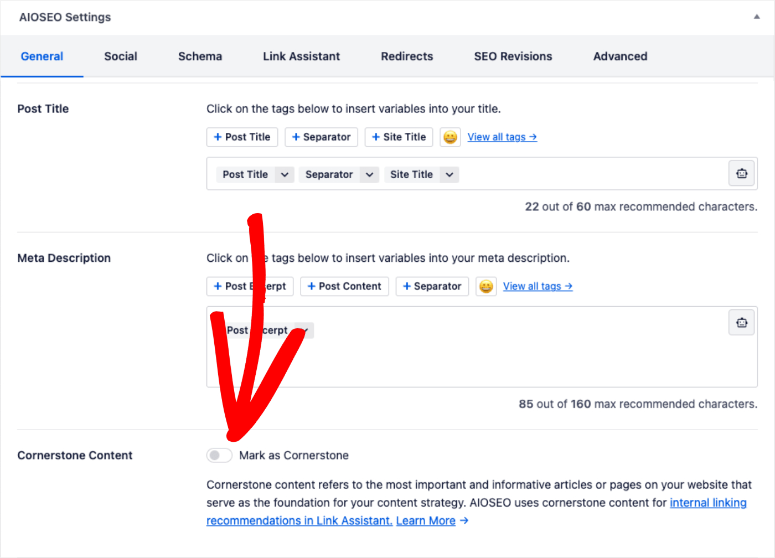

We do this because the Link Assistant AIOSEO feature prioritizes these pages in its recommendation algorithm.
As a result, your cornerstone content receives more linking suggestions and appears with special building icons throughout the interface.
I typically mark 3-5 pillar pages per topic cluster. Any more than that dilutes the authority signal you’re trying to build.
Step 2: Access Your Linking Opportunities Dashboard
Next, go to AIOSEO » Link Assistant » Links Report and select the “Linking Opportunities” filter. This reveals your automation goldmine.
Each post shows two critical metrics:
- Inbound Internal Suggestions: Links TO this content from other pages
- Outbound Internal Suggestions: Links FROM this content to other pages
The magic happens when you see both numbers. This indicates content that deserves links AND can strategically connect to other relevant pieces.


Step 3: Link Everything Together
Here’s my simple approach that builds maximum authority:
Start with your most important pages first, then connect related topics together. Work through your content step by step to create clear connections that make sense.
1. Start with cornerstone priority.
- Click on posts that have suggestions linking TO your cornerstone pages (look for posts with numbers in the “Suggestions” column)
- Review the individual link suggestions that appear when you expand each post
- Add the most relevant suggestions that connect to your pillar pages first
- This signals to Google that these pages are your most important resources


2. Connect cluster content next.
- Look for posts within the same keyword clusters from your LowFruits research
- Click on posts that can link to related articles within each topic area
- Focus on suggestions that connect pages covering similar or related topics
- These natural relationships create the topical coherence Google rewards
3. Build your support structure.
- Find posts where long-tail articles can link back to relevant cluster and pillar pages
- Click through posts that cover specific, detailed topics
- Add suggestions that point back to your broader, more comprehensive content
- This creates upward link equity flow that builds authority
The process works by clicking individual posts with suggestions, looking at the specific linking opportunities, and adding the ones that make sense for your topic authority goals.
Within 30 minutes of steady work, you’ll turn scattered content into a connected network that Google recognizes and rewards.
Step 4: Optimize Your Anchor Text Strategy
I always advise that you don’t use AIOSEO’s default anchor text suggestions without review. Instead, hover over any suggestion and click the edit icon to customize.
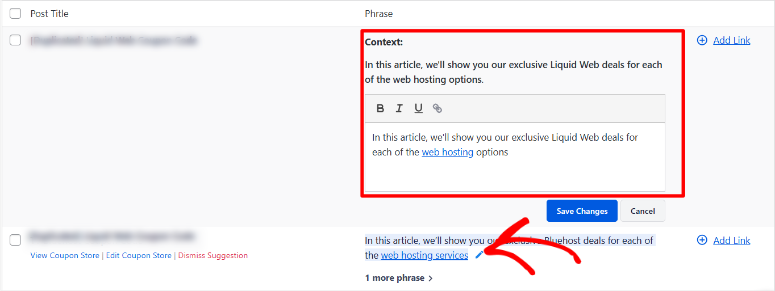

Use your LowFruits keyword research to guide anchor text choices:
- Pillar pages: Broader, authority-building terms
- Cluster pages: Specific semantic keywords
- Long-tail content: Natural, descriptive phrases
My rule is always to ensure that the anchor text feels natural to readers while including strategic keywords that reinforce topical relevance.
Also, avoid one or two-word anchor text. You need to give both Google and your users context about the link for it to carry more weight. Instead, try 3 or 4-word anchor texts.
Step 5: Fix Orphaned Content
One of the biggest threats to your site’s authority is orphaned pages. As mentioned, these are pages on your site that have zero internal links pointing to them from other pages.
Think of it this way: if Google can’t easily find these pages through your site’s link structure, it assumes they’re not important. Plus, visitors can’t discover this content naturally while browsing your site.
As a result, orphaned pages hurt your topic authority because they sit disconnected from your content clusters. Instead of contributing to your expertise signals, they just waste potential.
To deal with this problem, navigate to AIOSEO » Link Assistant » Overview and check your Orphaned Posts count.


Here, make sure you fix these orphaned pages by adding relevant inlinks and outlinks. You should always base this on content quality and keyword relevance to your topic clusters.
I always aim for zero orphaned posts on authority sites. In the end, every piece of content should connect logically to your topic ecosystem.
Step 6: Configure Quality Control Settings
Now, to make this process even faster, the AIOSEO Link Assistant feature offers a bulk edit option.
This lets you select multiple link suggestions using the checkboxes on the left, then add them all at once with a single click.
It’s a huge time-saver because instead of clicking “Add Link” dozens of times individually, you can process entire batches of strategic internal links in seconds.
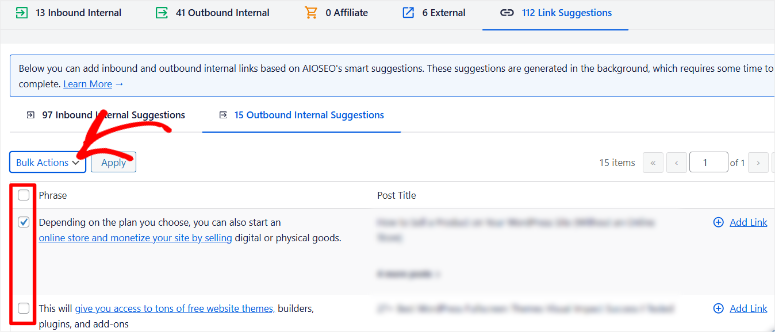

Before bulk-adding hundreds of links, set strategic boundaries in AIOSEO » Link Assistant » Settings:
- Words to Ignore: Add broad terms to prevent over-linking
- Sentences to Skip at Beginning: Set to 2-3 to avoid cluttering introductions
- Exclude Posts/Pages: Remove low-quality or outdated content from linking suggestions so link equity only flows to your best, most relevant pages


The result?
Your SEOBoost-optimized content becomes strategically connected through internal links guided by LowFruits keyword clusters.
This creates the comprehensive topic authority that Google recognizes and rewards with higher rankings across your entire content library.
Congratulations! You can now create topical authority through interlinking and good content structure. With this approach, search engines can place your content in the most relevant search result pages.
On top of that, your readers will think of you as an authority in the space since you not only show them content on the topic, but also show that you understand subjects around the topic through your internal links.
How to Track Content Performance
Building topic authority through strategic interlinking isn’t a set-it-and-forget-it process. You need to track specific metrics to see if your linking strategy actually works and where you can improve it.
So how do you actually track your content performance?
1. Use Google Analytics 4
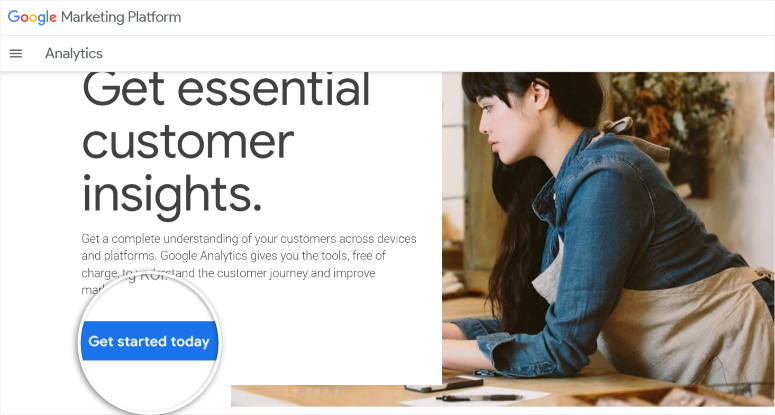

First, open Google Search Console and navigate to Links » Internal Links. You should see your cornerstone pages appearing in the “Most Linked Pages” section within 2-3 weeks.
In Google Analytics, monitor these key indicators:
- Pages per session increase (users exploring more content)
- Session duration improvements on pillar pages
- Reduced bounce rate on previously orphaned content
Check out these guides to properly set up the metrics above and more.
2. Use MonsterInsights
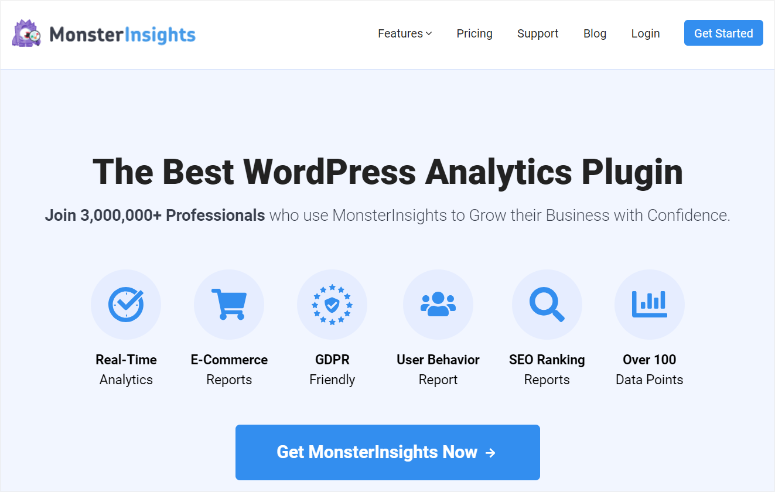

Looking for a more efficient way to track your content performance?
To keep with the theme of this guide’s simplicity, I recommend using MonsterInsights. It allows you to see your Google Analytics metrics without ever leaving your WordPress dashboard.
The plugin shows your internal linking success right in WordPress:
- Top performing pages from increased internal links
- User behavior flow between linked content
- Engagement improvements on previously orphaned posts
Check out my complete MonsterInsights review here.
Apart from that, here are other WordPress statistics plugins you can use instead:
3. Use LowFruits


You can also use LowFruits’ built-in keyword tracker to monitor how your target keywords perform over time.
Since you already identified your keyword clusters during the research phase, add these keywords to the tracker to see if your internal linking strategy helps you climb the rankings.
The tracker shows position changes, so you can see which topic clusters are gaining authority and which ones need more internal linking support.
How to Scale Your Topic Authority
As you can see, building topic authority isn’t a one-time setup. It’s an ongoing process that builds over time. Here’s how I maintain and scale the system for maximum expert positioning.
Monthly Maintenance Routine
- Week 1: Review new linking opportunities in AIOSEO Link Assistant. Add 10-15 high-quality connections between related content.
- Week 2: Run orphaned content audit. Any new pages with zero inbound links get immediate attention.
- Week 3: Use LowFruits to identify new keyword opportunities within your existing topic clusters. Plan content that fills gaps.
- Week 4: SEOBoost audit of cornerstone pages. Ensure your most-linked content maintains optimization scores above 80.
This 30-minute weekly routine prevents authority decay and identifies expansion opportunities.
Long-term Authority Building Tactics
- Go in-depth on fewer topics first, rather than covering many topics lightly. Instead of covering 10 topics superficially, dominate 3-4 topic areas completely.
- Create content specifically for internal linking. When you spot a gap in your topic coverage, create comprehensive content designed to become a major linking hub.
- Monitor competitor topic expansion. Use SEOBoost’s competitor analysis to see when rivals enter your topic areas. Create superior content and link to it strategically.
That’s It! You are now well-equipped to dominate your niche with content authority through interlinking.
This will help you become the site Google automatically considers when someone searches any keyword in your topic areas.
If anything is unclear, check out the commonly asked questions below.
FAQs: How I Use Interlinking to Improve Traffic
How many internal links are too many on a single page?
I aim for 8-12 internal links per 1,500-word article. The key isn’t hitting a specific number, but ensuring each link adds genuine value for readers. AIOSEO Link Assistant helps by suggesting only contextually relevant opportunities. If a page feels cluttered or links seem forced, you’ve gone too far.
Can this interlinking strategy work with any WordPress theme?
Absolutely. AIOSEO Link Assistant works at the content level, not the theme level. I’ve implemented this on everything from basic blog themes to complex business sites. The internal links appear as standard HTML links that work with any properly coded WordPress theme.
What if I have a small site with limited content?
Start with what you have. Even 20-30 pieces of content can benefit from strategic internal linking. Focus on creating 2-3 solid topic clusters rather than trying to cover everything. As you add content, AIOSEO automatically finds new linking opportunities. Quality beats quantity for authority building.
How long before I see topic authority improvements?
Most sites see initial improvements within 4-6 weeks. MonsterInsights will show increased pages per session and longer engagement times first. Rankings typically improve in 8-12 weeks as Google recognizes your comprehensive topic coverage. Remember, authority building is a marathon, not a sprint.
Final Thoughts: Is Internal Linking That Important for SEO?
Yes, it is. In fact, it is more important now with Google’s new ranking approach.
Plus, building topic authority through strategic internal linking changed how I approach SEO.
Instead of chasing individual keyword rankings, I now create comprehensive expertise that positions me as the go-to source in my niche.
The combination of AIOSEO Link Assistant’s automation, LowFruits’ opportunity identification, and SEOBoost’s content optimization creates a system that scales with your growth.
Apart from that, tools like MonsterInsights keep you informed without complexity.
Most importantly, this approach builds lasting value. While others chase algorithm updates, you’re creating the kind of comprehensive resource that deserves top rankings regardless of Google’s changes.
Resource Center
Building topic authority is just one part of your complete SEO strategy. Check out these related guides to strengthen your WordPress site’s search performance even more.
These guides will help you build a complete SEO foundation that works with your new internal linking strategy.
Start with one resource that matches your biggest need, then work through the others as your site grows.
منبع: https://www.isitwp.com/best-ai-seo-strategy/
